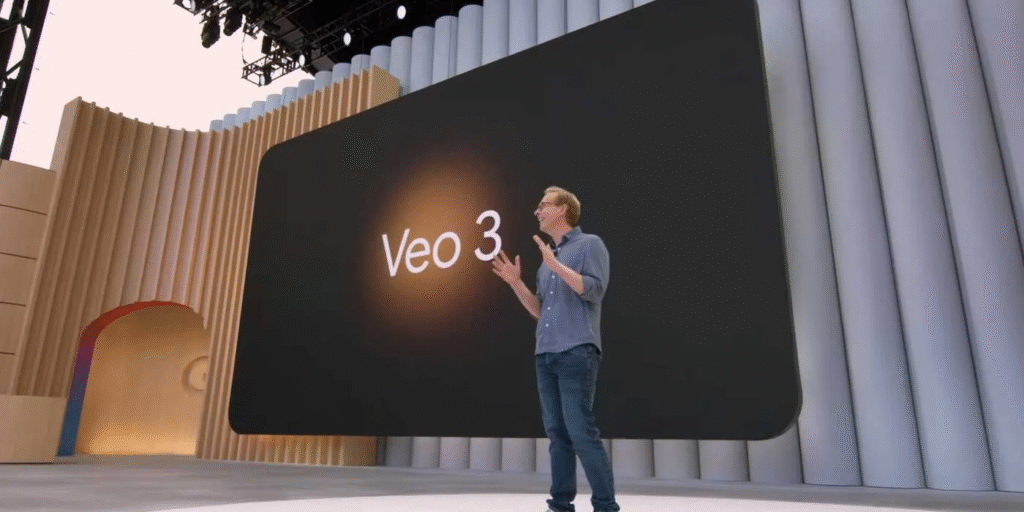At the end of May this year, Google, through its DeepMind division, officially launched Veo 3, the third generation of its artificial intelligence designed for video generation. This tool represents a significant leap in automated audiovisual content creation, allowing anyone to transform textual descriptions into videos with cinematic quality.

Veo 3 is the result of years of research into multimodal generative models, combining advances in natural language processing, computer vision, and video synthesis. It can interpret complex commands and generate videos lasting over a minute, in Full HD (1080p) resolution, with impressive fluidity and realism.
The development of Veo 3 involved integrating several of Google’s previous technologies, such as Imagen Video, Phenaki, and the Gemini language models. The DeepMind team worked to unify these approaches into a single robust system capable of understanding linguistic nuances and translating them into coherent visual scenes.

One of Veo 3’s major differentiators is its ability to maintain visual consistency across multiple scenes. This means that characters, settings, and objects retain their visual characteristics even when appearing at different moments in the video—something that was a challenge in previous versions.
The AI also understands technical terms from cinematic vocabulary. Commands like “one-shot sequence,” “timelapse,” “aerial shot,” or “noir style” are interpreted accurately, allowing users to have creative control over the style and narrative of the generated video.
The system was trained on a vast dataset of visual and audiovisual content, adhering to ethical and privacy guidelines. Google states that it used only licensed or public domain content and applied filters to prevent the generation of sensitive or misleading material.
Veo 3 also introduces AI-generated audio, including soundtracks, sound effects, and even dialogues with natural intonation. This is made possible through integration with voice and sound synthesis models like AudioLM, also developed by Google.
The tool is available through Google Flow, an experimental platform accessible via Google Labs. Users can create projects, input prompts, and generate videos directly in the interface, with editing options and fine adjustments via text commands.
To full use of the tool is tied to the Google Gemini Ultra plan, formerly known as Google One AI Premium.
The Google Flow interface allows users to save projects, share videos, and even collaborate in real time. This opens doors for educational, commercial, and artistic uses, democratizing access to high-quality audiovisual production.
Technically, Veo 3 uses an architecture based on multimodal transformers, with specialized modules for text, image, motion, and sound. These modules work in sync to generate cohesive and expressive videos.
The AI is also capable of performing intelligent edits. For example, a user can request “add a storm in the background” or “change the style to cyberpunk,” and the system adjusts the video automatically without needing to start over.
The impact of Veo 3 is already being felt in areas such as advertising, education, independent filmmaking, and social media. Small businesses and individual creators now have access to a tool that previously required entire teams and large budgets.
Google has also implemented safety and transparency mechanisms. Each video generated by Veo 3 includes metadata indicating its synthetic origin, helping to combat misinformation and misuse of the technology.
The arrival of Veo 3 in Brazil was marked by great interest, with servers temporarily overloaded in the first days of access. This demonstrates the public’s appetite for creative tools powered by AI.
The creative community has already begun exploring Veo 3’s potential in short films, music videos, trailers, and even educational videos. The ability to generate visual and audio content from written ideas is transforming the creative process.
Veo 3 also represents an advance in creative accessibility. People with technical or physical limitations can now express their visual ideas easily, simply by describing what they want to see.
In comparison, Veo 3 outperforms competitors like Runway, Pika Labs, and Sora (from OpenAI) in aspects such as visual fidelity, video duration, and sound integration, establishing Google as a leader in this segment.
The launch of Veo 3 marks a new chapter in the evolution of multimodal generative AIs. It shows how the combination of language, image, and sound can be orchestrated by algorithms to create complete audiovisual experiences.
Google Veo 3 is not just a video generation tool—it is a new paradigm in how we imagine, create, and share stories. It ushers in an era where human creativity is amplified by increasingly sophisticated artificial intelligences.
#datavizmagic #datavizshow #datastorytelling #datavisualization #resources

